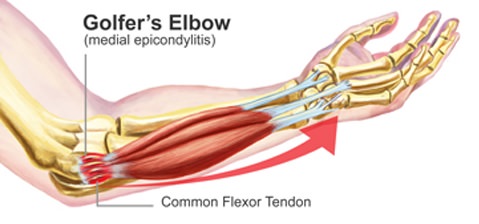Golfer’s elbow is also known as medial epicondylitis and is similar to tennis elbow or lateral epicondylitis. Both conditions are problems related to degenerative changes in the tendons of the forearm muscles. Golfer’s elbow is less common than tennis elbow, making up around 10-20% of all elbow tendon problems.
What is Golfer’s Elbow?
Golfer’s elbow is a condition giving pain and weakness on the inside of the forearm close to the elbow. Degenerative changes or tendonitis occur in the tendons of the gripping muscles of the forearm, most common involving the muscles called pronator teres and flexor carpi radialis.
The medial epicondyle is where the tendons of the forearm flexor and pronator muscles originate. It’s the bony lump you can easily feel on the inside of your elbow.
Who Gets Golfer’s Elbow?
Golfer’s elbow is an overuse injury so typically occurs in manual occupations and vigorous sports. Golfers may suffer from it but it has also been reported in weight lifters, archers, cricket bowlers and people in throwing sports.
What Causes Golfer’s Elbow
Repetitive stresses put upon the tendons at their common origin over time cause changes in the tendon structure. Inflammation does not appear to be a major part of this process so it is called a tendinopathy, a degenerative process that changes the tendon’s internal structure.
In throwing and golfing the stresses tend to move the forearm away from the upper arm in a “knock elbow” direction and the repetition of this is thought to contribute towards the tendon changes.
Errors in technique, both in equipment and in behaviour, such as increasing the intensity of training suddenly, may contribute to this problem. Weakness and lack of endurance in the wrist flexors may also be factors when an increased load is required.
Golfer’s Elbow Symptoms
Aching over the inner side of the elbow is the typical symptom, worse on activity and specific movements. Grip strength may be reduced. Around 20% of people with this problem have involvement of the ulnar nerve, which is nearby.
On examination there will be tenderness over the tendons at the epicondyle. Getting the person to flex (bend) their wrist forwards and then resist the movement will cause pain over the affected area. Pain may also occur while resisting turning the palm down and even bending the elbow.
Golfer’s Elbow Treatment
Physiotherapy is the first line of treatment. Various electromagnetic treatments have been used but the evidence for their usefulness is lacking. Strengthening exercises and stretching may give a moderate effect over a short period.
Painkillers and the PRICE method are the best approach to acute medial epicondylitis. Ice can be applied for 10-15 minutes to the area but care needs to be taken not to overcool the ulnar nerve nearby, causing to malfunction, although usually only temporarily.
Rest from the aggravating activity is a vital measure and often one that athletes and other sports persons are unhappy with. A reduction in the intensity of, frequency of or time spent in the activity may be enough to alleviate symptoms. Modification of training and performance techniques may be useful as may be the wearing of braces and splints.
Golfer’s Elbow Surgery
Surgery is only considered if the pain problem is severe enough and treatment over a reasonable period has failed to improve things. A routine operation is to take off the tendons from their origin on the bone and cut out the pathological tissue, allowing the tendons to re-attach again afterwards. Four to six months may be required to go back to vigorous activity.
Steroid Injections for Golfer’s Elbow
Steroid injections can improve acute symptoms of golfer’s elbow but do not have an effect in the long term.
Other treatments, for which evidence is not very strong, are autologous blood injection (injecting your own blood into the area to stimulate inflammation), botulinum injection and extracorporeal shock wave therapy (ESWT).
As the patient recovers after treatment physiotherapy can ensure they continue with forearm stretching and strengthening over the long term. A change of job or of the working environment may be required to allow the person to continue to work without undue problems.
References:
- Medial Epicondylitis – Medscape – http://emedicine.medscape.com/article/97217-overview
- Golfer’s Elbow – Medial Epicondylitis – https://www.nlm.nih.gov/medlineplus/ency/article/007638.htm
Last Review Date: 11-01-2018
Next Review Date: 04-03-2020

